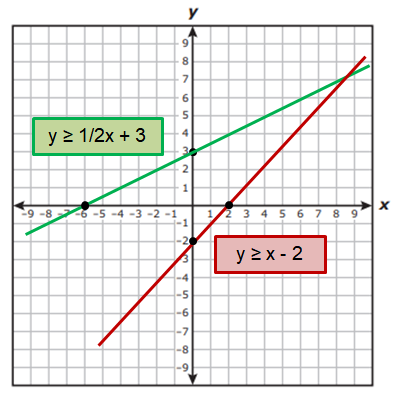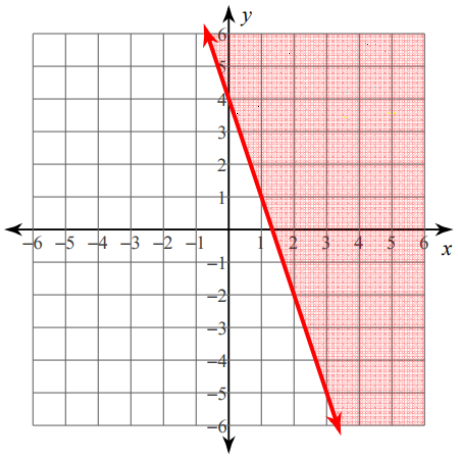GRAPHING LINEAR INEQUALITIES
Subscribe to our ▶️ YouTube channel 🔴 for the latest videos, updates, and tips.
To obtain the common region for both given linear inequalities, we have to follow the steps given below.
Step 1 :
First, we have to assume the given inequalities as equations.
Then, we have to draw the graph of the line using x and y-intercepts.
Step 2 :
The region which satisfies the inequality can be shaded.
To check if the inequality is being satisfied by applying any point from the region, the point which satisfies the inequality is known as the solution region and that can be shaded.
Step 3 :
Do the process explained in step 2 for the second inequality.
Step 4 :
The overlapping region is the solution region for the system of inequalities given.
Example 1 :
Graph the system of linear inequalities.
y ≥ 1/2x + 3
y ≥ x - 2
Solution :
Given,
y ≥ 1/2x + 3 and y ≥ x - 2
Converting the inequalities into equations.
y = 1/2x + 3 and y = x - 2
To graph the line y = 1/2x + 3, we find x and y intercepts.
|
x-intercept : Put y = 0 y = 1/2x + 3 0 = 1/2x + 3 -1/2x = 3 x = -6 |
y-intercept : Put x = 0 y = 1/2x + 3 y = 1/2(0) + 3 y = 3 |
To graph the line y = x - 2, we find x and y intercepts.
|
x-intercept : Put y = 0 y = x - 2 0 = x - 2 x = 2 |
y-intercept : Put x = 0 y = x - 2 y = 0 - 2 y = -2 |
The point on the line y = 1/2x + 3 are (-6, 0) and (0, 3)
The point on the line y = x - 2 are (2, 0) and (0, -2)
By plotting the points on the graph, we get

If x = 1 and y = 4, then y ≥ 1/2x + 3 (True)
So, we can shade the region which is above to y ≥ 1/2x + 3.
If x = -7 and y = 4, then y ≥ x - 2 (True)
So, we can shade the region which is above to y ≥ x - 2.

Example 2 :
Graph the system of linear inequalities.
y ≥ 2x + 3
y ≤ x - 2
Solution :
Given,
y ≥ 2x + 3 and y ≤ x - 2
Converting the inequalities into equations.
y = 2x + 3 and y = x - 2
To graph the line y = 2x + 3, we find x and y intercepts.
|
x-intercept : Put y = 0 y = 2x + 3 0 = 2x + 3 -2x = 3 x = -3/2 |
y-intercept : Put x = 0 y = 2x + 3 y = 0 + 3 y = 3 |
To graph the line y = x - 2, we find x and y intercepts.
|
x-intercept : Put y = 0 y = x - 2 0 = x - 2 x = 2 |
y-intercept : Put x = 0 y = x - 2 y = 0 - 2 y = -2 |
The point on the line y = 2x + 3 are (-3/2, 0) and (0, 3)
The point on the line y = x - 2 are (2, 0) and (0, -2)
By plotting the points on the graph, we get

If x = -3 and y = 4, then y ≥ 2x + 3 (True)
So, we can shade the region which is left to y ≥ 2x + 3.
If x = 4 and y = -4, then y ≤ x - 2 (True)
So, we can shade the region which is right to y ≤ x - 2.

Example 3 :
Write the inequality for the graph given below.

Solution :
From the above graph, first let us find the slope and y-intercept.
Rise = - 3 and Run = 1
Slope = - 3 / 1 = - 3
y-intercept = 4
So, the equation of the given line is
y = - 3x + 4
But, we need to use inequality which satisfies the shaded region.
Because the graph contains solid line, we have to use one of the signs ≤ or ≥.
To find the correct sign, let us take a point from the shaded region.
Take the point (2, 1) and substitute into the equation of the line.
y = - 3x + 4
That is,
1 = - 3(2) + 4
1 = - 6 + 4
1 = - 2
Here, 1 is greater than -2. So, we have to choose the sign ≥ instead of equal sign in the equation y = -3x + 4
Therefore, the required inequality is
y ≥ - 3x + 4.
a) Write an equation represented by the dashed line.

b. The solutions of an inequality are represented by the shaded region. In words, describe the solutions of the inequality.
c. Write an inequality represented by the graph. Which inequality symbol did you use? Explain your reasoning.
Solution :
a) By observing the graph, y-intercept = -3
Rise = 3, run = 3
Slope = 3/3
= 1
y = mx + b
Equation represented by the line
y = 1x - 3
b) Some of the points on the shaded region are,
(2, -2) (1, -3) and (3, -2)
c) To choose the inequality sign, we have to select one of the points in the equation,
-2 = 1(2) - 3
-2 = 2 - 3
-2 < -1
So, the correct inequality sign is y < 1x - 3.
Subscribe to our ▶️ YouTube channel 🔴 for the latest videos, updates, and tips.
Recent Articles
-
Finding Range of Values Inequality Problems
May 21, 24 08:51 PM
Finding Range of Values Inequality Problems -
Solving Two Step Inequality Word Problems
May 21, 24 08:51 AM
Solving Two Step Inequality Word Problems -
Exponential Function Context and Data Modeling
May 20, 24 10:45 PM
Exponential Function Context and Data Modeling